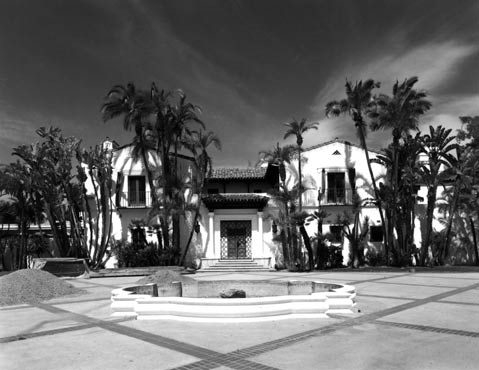The Bryce Estate
Florestal Built By Architect George Washington Smith.

One of the oldest and most magnificent estates in Hope Ranch is Florestal on Roble Drive. Completed in 1927 for Peter Cooper Bryce and his wife, Angelica, the home was designed by George Washington Smith, the outstanding practitioner of the Spanish Colonial Revival style.
Bryce was born in New York City in 1889. His grandfather, Peter Cooper, designed one of the first steam locomotives in the U.S. and had founded Cooper Union, one of the first engineering schools, now an important art school. Bryce’s father, Lloyd Stephens Bryce, publisher of a literary journal, passed on to his son a deep love of books.
In 1917, Bryce married Angelica Schuyler Brown, nicknamed Girlie, a member of an old banking family. This vivacious young woman often figured prominently in the society pages of the day. The couple honeymooned in Santa Barbara and determined to someday make it their home. In 1923, Bryce bought 52 acres in Hope Ranch after leasing winter homes in Montecito for a number of years.
In 1925, the Bryces began discussions with George Washington Smith about their new Hope Ranch home, with Mrs. Bryce working especially closely with the architect regarding design elements for the estate. Smith proposed a home in the Spanish Colonial Revival style, the style in which he had already made a national name for himself. The home would feature three enclosed courtyards. Angelica Bryce traveled to Spain to pick up design ideas and furnishings for the house. Cases of materials were shipped to Santa Barbara. The fountain in the first courtyard is based on one of her sketches.
Other features of the house included a magnificent library. Here Peter Bryce housed his collection of some 3,000 volumes. Among the rarities was the handwritten manuscript for the short story “The Jumping Frog of Calaveras County” by Mark Twain. The couple often entertained in their cabana, on the beach below the house. It was reached by an electrical funicular railway installed by the Otis Elevator Company.
The 1925 earthquake caused a change in the plans for the house. It was decided to move the residence back away from the ocean bluff. This did not sit well with Angelica Bryce, who wanted a full ocean view. She instructed that the bluff side be flooded to erode it away. Reportedly, the resulting mud flow drifted all the way to Carpinteria. Work began on the house of more than 12,000 square feet in March 1926 and took about a year. Since the early 1980s, more than 9,200 square feet have been added to the house.
Both the Bryces were avid horticulturalists-hence the name of the estate. Angelica was especially known for her experimentation with roses. Peter was a recognized expert on orchids, developing types that had fragrances. The two were also animal lovers; the estate was home to dogs, cats, peacocks, a tortoise, and even a cow.
Angelica loved the stage and took part in a number of productions in the area, including 1924’s Beggar on Horseback, the first production staged in the second Lobero Theatre. She numbered Ronald Coleman and Douglas Fairbanks among her friends. She was a founder of the Junior League in Santa Barbara and served as its first president. Peter was also active in the community. He was one of the founders of the Valley Club in Montecito and was a shareholder in the Biltmore Hotel.
Peter Bryce died in 1964. Mrs. Bryce lived on in the family home until her death at age 90 in 1980. Florestal was sold the following year and has since gone through the hands of a number of owners.



